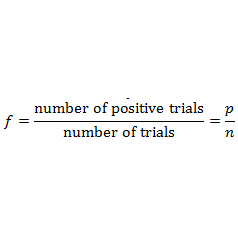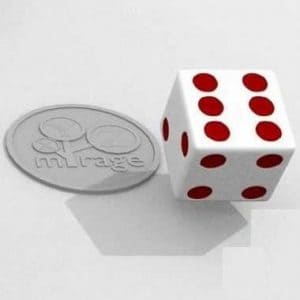Sample space contains total number of the possible outcomes. A sample space is denoted by ‘S’ and the number of possible outcomes is denoted by n(S). Favorable elements are subset to the entire sample space and denoted by ‘E’ or any our excited notations. The number of favourable elements is denoted by n(E). Elements are often meaning as ways or members of an event.
Probability is equal to be a quotient that n(E) is divided by n(S). Probability is denoted by italicized P, ‘P’. Hence

For now we just want to describe each sample space of the examples.
Ex1. Two coins (a one cent coin and a two cent coin) are tossed once. Find a sample space.
Solution: Clearly the coins are distinguishable in the sense that we can speak of the first coin and the second coin. Since either coin can turn up Head (H) or Tail (T), the possible outcomes may be Heads on both coins =(H,H) =HH
Head on first coin and Tail on the other =(H,T) =HT
Tail on first coin and Head on the other =(T,H) =TH
Tail on both coins =(T,T) =TT
Thus, the sample space is S ={HH,HT,TH,TT}
Our-note: The outcomes of this experiment are ordered pairs of H and T. For the sake of simplicity the commas are omitted from the ordered pairs.
Ex2. Consider the experiment in which a coin is tossed repeatedly until a head comes up. Describe the sample space.
Solution: In the experiment head may come up on the first toss, or the 2nd toss, or the 3rd toss and so on till head is obtained. Hence, the desired sample space is
Ex3. A coin is tossed three times.
solution:
A coin has two faces: head (H) and tail (T).
When a coin is tossed three times, the total number of possible outcomes is 23=8. Thus, when a coin is tossed three times, the sample space is given by:
Ex4. A coin is tossed four times.
solution:
When a coin is tossed once, there are two possible outcomes: head (H) and tail (T).
When a coin is tossed four times, the total number of possible outcomes is 24=16
Thus, when a coin is tossed four times, the sample space is given by:

Ex5. A coin is tossed and a die is thrown.
Solution:
A coin has two faces: head (H) and tail (T).
A die has six faces that are numbered from 1 to 6, with one number on each face.
Thus, when a coin is tossed and a die is thrown, the sample space is given by:
Ex6. A coin is tossed and then a die is rolled only in case a head is shown on the coin.
Solution:
A coin has two faces: head (H) and tail (T).
A die has six faces that are numbered from 1 to 6, with one number on each face. Thus, when a coin is tossed and then a die is rolled only in case a head is shown on the coin, the sample space is given by:
Throwing a die
The set S of all possible outcomes of a random experiment is called the sample space or probability space. Every subset of a sample space is an event.
For example:
On throwing a die, the sample space
S={1,2,3,4,5,6} and n(S)=6
E={1,3,5} is a subset of S. So E is an event and n(E)=3.
The event E={1,3,5} is also expressed as the event of getting an odd number in throwing a die.
Ex7. Find the sample space associated with the experiment of rolling a pair of dice (one is blue and the other red) once. Also, find the number of elements of this
sample space.
Solution: Suppose 1 appears on blue die and 2 on the red die. We denote this outcome by an ordered pair (1,2). Similarly, if ‘3’ appears on blue die and ‘5’ on red, the outcome is denoted by the ordered pair (3,5).
In general each outcome can be denoted by the ordered pair (x,y), where x is the number appeared on the blue die and y is the number appeared on the red die.
Therefore, this sample space is given by S={(x,y): x is the number on the blue die and y is the number on the red die}.
The number of elements of this sample space is 6×6=36 and the sample space is given below:

Ex8. A die is thrown two times.
solution:
When a die is thrown, the possible outcomes are 1, 2, 3, 4, 5, or 6. When a die is thrown two times, the sample space is given by S={(x,y):x,y=1,2,3,4,5,6}
The number of elements in this sample space is 6×6=36, while the sample space is
given by:

Ex9. Suppose 3 bulbs are selected at random from a lot. Each bulb is tested and classified as defective (D) or non-defective (N). Write the sample space of this experiment.
Solution:
Three bulbs are to be selected at random from the lot. Each bulb in the lot is tested and classified as defective (D) or non-defective (N).
The sample space of this experiment is given by
Ex10. An experiment consists of tossing a coin and then throwing it second time if a head occurs. If a tail occurs on the first toss, then a die is rolled once. Find the sample space.
Solution:
A coin has two faces: head (H) and tail (T).
A die has six faces that are numbered from 1 to 6, with one number on each face.
Thus, in the given experiment, the sample space is given by
Ex11. The numbers 1, 2, 3 and 4 are written separatly on four slips of paper. The slips arc put in a box and mixed thoroughly. A person draws two slips from the box, one after the other, without replacement. Describe the sample space for the experiment.
Solution:
If 1 appears on the first drawn slip, then the possibilities that the number appears on the second drawn slip are 2, 3, or 4. Similarly, if 2 appears on the first drawn slip, then the possibilities that the number appears on the second drawn slip are 1, 3, or 4. The same holds true for the remaining numbers too. Thus, the sample space of this experiment is given by

Ex12. A coin is tossed. If it shows a tail, we draw a ball from a box which contains 2 red and 3 black balls. If it shows head, we throw a die. Find the sample space for this experiment.
Solution:
The box contains 2 red balls and 3 black balls. Let us denote the 2 red balls as R1, R2 and the 3 black balls as B1, B2, and B3. The sample space of this experiment is given by
Ex13. An experiment consists of rolling a die and then tossing a coin once if the number on the die is even. If the number on the die is odd, the coin is tossed twice. Write the sample space for this experiment.
Solution:
A die has six faces that are numbered from 1 to 6, with one number on each face. Among these numbers, 2, 4, and 6 are even numbers, while 1, 3, and 5 are odd numbers.
A coin has two faces: head (H) and tail (T).
Hence, the sample space of this experiment is given by:

Ex14. A coin is tossed. If it shows head, we draw a ball from a bag consisting of 3 blue and 4 white balls; if it shows tail we throw a die. Describe the sample space of this experiment.
Solution: Let us denote blue balls by B1, B„ B3and the white balls by W1,W2,W3,W4. Then a sample space of the experiment is

Here HBi means head on the coin and ball B is drawn, HWi means head on the coin and ball Wi is drawn. Similarly, Ti means tail on the coin and the number i on the die.
We are sorry but those examples are just dessert. Either sample space or favorable elements of more crucial events has been served on Mathlibra’s posts of the tags permutations and combinations. Let’s check them out.





